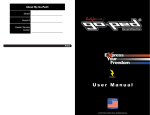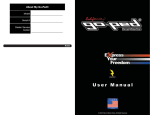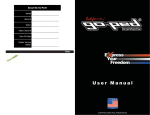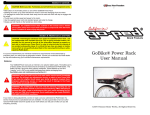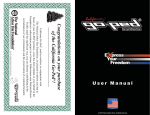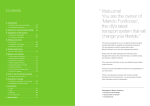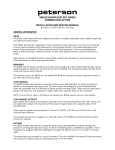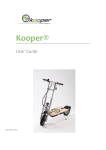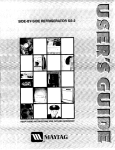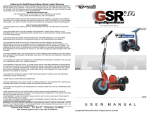Download About My Go-Ped® Model
Transcript
About My Go-Ped® Model _______________________ Serial # _______________________ Dealer Service Center _______________________ Notes WHAT WE GUARANTEE AND WHAT YOU PROMISE US Patmont Motor Werks, a Nevada Corporation (hereinafter referred to as “P.M.W.”) expressly warrants that each of its products is free from defects in material and workmanship under normal operating conditions and according to proper use for a period of 90 days from the date of original purchase. Normal operating conditions require adequate fuel / oil ratio and / or routine care and maintenance by the purchaser of the product. Proper use means that the P.M.W. transportation product is to be used only in the manner intended for personal transportation of a single rider with proper safety equipment described on the RED SAFETY WARNING LABEL affixed to the product. P.M.W. Transportation Products are intended for use only with the proper safety equipment on smoothly paved, safe, dry, non-oily surfaces in accordance with local regulations during daylight hours. In express consideration for purchasers execution of the limited warranty and liability agreement, P.M.W. will repair or replace any part or component, other than tires, of the P.M.W. transportation product free of charge to the original purchaser who registers his/her product under the warranty program. Warranty service can be obtained by calling your local dealer or the Tech. Line at (925) 373-7827 and following the instructions given by the service representative. Shipping costs will be at the purchasers’ expense. This warranty does not apply to tire wear, operation under abnormal conditions or damage to the vehicle brought on by improper use. Racing, competitive or commercial use, or modification of the product shall void this express limited warranty. All models with the G260RC engine and the GSR40i are not warranted for piston/cylinder seizure due to adjustability of the carburetor, that can be tampered by end user. Engine crankshaft failures on spindle drive models are not covered under warranty due to varying riding styles and the adjustability of the tire to spindle pressure by end user. Purchaser herewith acknowledges: (a) P.M.W. assumes no liability for any misuse of any of its transportation products. (b) Under this limited warranty and liability agreement P.M.W. shall have no obligation and the purchaser or user shall have no remedy against P.M.W., its officers, agents or assigns for any damages, including without limitation, incidental, consequential, special, punitive damages arising from direct or indirect injury to person or property, or any other loss, whether or not occasioned by negligence, or otherwise, on the part of P.M.W. (c) Purchaser acknowledges that there is an inherent risk in the operation of motorcycles, bicycles, mopeds, and all P.M.W. transportation products, and herewith assumes the risk of any injury arising from operation of any P.M.W. transportation product. Original owner will indemnify and hold P.M.W. harmless and will take full responsibility for conveying all safety warnings, instructions, and limited warranty if unit is sold, lent, or otherwise transferred to other persons and will indemnify P.M.W. from any claims against it for original owners’ failure to do so. THE EXPRESS LIMITED WARRANTY DESCRIBED ABOVE SHALL BE EXCLUSIVE AND THERE IS NO OTHER WARRANTY OR LIABILITY, EXPRESS OR IMPLIED, ARISING BY LAW OR OTHERWISE AND WHETHER OR NOT OCCASIONED BY SELLER’S NEGLIGENCE. THERE IS NO IMPLIED WARRANTY OF MERCHANTABILITY OR FITNESS FOR A PARTICULAR PURPOSE. THERE ARE NO WARRANTIES WHICH EXTEND BEYOND THOSE EXPRESSLY STATED HEREIN. NOTICE: Some states do not allow the exclusion or limitation of incidental or consequential damages and some states do not allow limitation on how long an implied warranty lasts, therefore, some of the above limitations may not apply to you. NOTICE: Your Homeowners Insurance may not cover either Direct or Third Party Liability Claims arising from use of this or any other Go-Ped® product. PLEASE ACKNOWLEDGE THAT YOU HAVE READ AND UNDERSTAND EACH WARNING _ This device does not conform to Federal Motor Vehicle Safety standards and is not intended for operation on public streets, roads or highways. _ Safety helmet, goggles, gloves, elbow, and knee pads, appropriate shoes, and bright clothing must be worn while operating this device to reduce potential of injury. _ Do not operate this device in traffic, or on wet, frozen, oily or unpaved surfaces. Avoid uneven surfaces, chuckholes, surface cracks, obstacles and night or conditions of darkness. _ Never carry passengers and objects that can hinder your abilities to safely operate your vehicle. _ Pregnant persons should not use this product. _ Never use alcohol or drugs before or while operating this device. They slow reaction time and impair judgment. _ This product should not be used by minors without adult supervision. _ High speeds, jumps and trick maneuvers are dangerous and could result in loss of control and other accidents. _ When accelerating or climbing hills, you will need to lean forward, under braking conditions you will need to lean back, to keep wheels in contact with the ground. _ Never permit a guest to use this device unless the guest has read the user manual and all labels. _ I agree to provide my guest with helmet, safety goggles, elbow pads, and knee pads. _ Engine shut off switch is available for rear wheel braking or for use in the event of throttle failure or other emergency when engine shut off is desired. _ This product should not be used by persons unwilling or unable to take responsibility for their own actions. _ Read all additional warnings and instructions in user manual before operating this P.M.W. product. _ Adults purchasing this Unit for Children, inclusive but not limited to a Parent or Guardian, assume direct liability for injury to the child, or to third parties to whom the child entrusts the vehicle. _ Homeowners Insurance may not cover either Direct or Third Party Liability Claims Arising from Use of this or any other GoPed® product. _ I herewith promise not to entrust this vehicle to any child under the age of 16 (Sixteen) years of age. _ Never remove exhaust tube from manifold of engine or serious damage to your GoPed and yourself will result. WE SETTLE ARGUMENTS BY ARBITRATION ANY DISPUTE HEREUNDER WILL BE RESOLVED THROUGH BINDING ARBITRATION IN THE CITY OF RENO, COUNTY OF WASHOE, NEVADA, ACCORDING TO THE RULES GERMANE TO ARBITRATIONS CONTAINED IN REVISED NEVADA STATUTES. WE AGREE TO HAVE ANY DISPUTES ARISING OUT OF THE MATTERS INCLUDED IN THE ‘ARBITRATION OF DISPUTES’ PROVISION DECIDED BY NEUTRAL ARBITRATION AS PROVIDED BY NEVADA LAW, AND THAT YOU ARE GIVING UP ANY RIGHTS YOU MIGHT POSSESS TO HAVE THE DISPUTE LITIGATED IN A COURT OR JURY TRIAL. BY SIGNING BELOW YOU ARE GIVING UP YOUR JUDICIAL RIGHTS TO DISCOVERY AND APPEAL, UNLESS THOSE RIGHTS ARE SPECIFICALLY INCLUDED IN THE ‘ARBITRATION OF DISPUTES’ PROVISION. IF YOU REFUSE TO SUBMIT TO ARBITRATION AFTER AGREEING TO THIS PROVISION, YOU MAY BE COMPELLED TO ARBITRATE UNDER THE AUTHORITY OF THE NEVADA CODE OF CIVIL PROCEDURE. YOUR AGREEMENT TO THIS ARBITRATION PROVISION IS VOLUNTARY. You should feel free to consult an attorney before signing this limited warranty and liability agreement. I have read understood and agreed to be bound by the limited warranty and liability agreement above and agree to submit disputes arising out of matters included in the arbitration of disputes provision to neutral arbitration. Section 8: Operator Tips to Improve Performance There are a lot of little things that an operator should do to unlock the full potential of the Electric Vehicle. In this section you will find some tips and advise intended to help you achieve that goal. 8.1 Keep Your Motor Cool. The most common method of damaging the unit is by over heating the motor. Motors can be over worked and eventually this will burn out the brush card inside the motor. Replacing a brush card is simple and straight forward but can be avoided. Avoid frequent accelerations, burnouts, towing heavy loads, long steep hill climbs, and the likes that require the motor to work harder. If you have been working the motor hard, reach down and carefully feel the temperature of it. The best place is at one of the 2 power terminals and if it is too hot to hold your hand/finger against then stop riding and give it a chance to cool down before continuing. These heavy loads also exert huge power draws from the batteries that drastically shorten your usable range and battery life. With that in mind, get into the practice of pushing off with the unit from a standing start to get some forward momentum before applying the throttle. A simple push off from all your dead stops can squeeze out another mile or more range as well as reduce the load and heat on the motor. In addition, keeping your speed relatively constant will also help maximizes available range. Don’t get dragged down. Brakes and chain should not be dragging or preventing the wheel from spinning freely. There is a small amount of natural drag created by the drive components but making sure they are in working order, properly lubricated, adjusted, and in alignment, will help ensure you are not losing any performance. Rolling. Make sure you have the proper pressure in the tires. There is a PSI tire pressure rating on the side wall on the tire and you should try to keep your ESR tires at that pressure at all times. We have found it is safe to go as high as 10 PSI above the rating on the sidewall. This will further reduce the rolling resistance of the tires and increase the usable range, acceleration, and speed. WARNING: DO NOT over inflate wheels more than 10 PSI above recommended levels market on the sidewall of the tire. 8.2 Battery Care Letting the batteries sit in the unit with a depleted charge is harsh on the chemistry that makes them functional and will greatly reduce their usable life. So, it is best to get in the practice of keeping them charged whenever possible. Charge For Storage. Do not leave unit on a charge for more then 1 week. Any longer and over charging can end up damaging the batteries or even create an potential fire hazard. If you plan to store the unit for more than a week you should first charge the unit fully then disconnect the charger to store and put the unit on a charge for a few hours once a month to insure the batteries stay “topped off”. 8.3 Riding surfaces to avoid Your unit incorporates some very sophisticated and sensitive electronic components that do not like heavy vibrations or shock loads that is typically associated with riding on an unpaved/uneven surface or hopping down street curbing. The occasional unavoidable bumps are OK but try to avoid rough terrain whenever possible. Weather Conditions to Avoid: Although some water resistance measures have been made, your Electric Vehicle is not completely sealed from the elements so driving the unit through standing water, wet or muddy conditions runs the risk of severely damaging it. The ideal solution to riding any 2-wheel vehicle in wet/muddy conditions is to just not do it. Clean is good. This does not mean you cannot wash or clean your unit. They like being shiny and clean as it helps prevent dirt from getting into the electronics. Therefore, when it is time to get the sparkle back in your unit you can do so with a mild soapy damp dish-towel and wipe it down. Just avoid heavy amounts of water that can end up finding its way to any of the electronics. Hot or Cold. Another weather conditions you should be aware of are extreme temperatures. The hotter the temperature the less efficient your unit will be so try to avoid operation on those very hot days. Also, avoid allowing your scooter to sit in freezing temperature as this could cause sever battery damage. Note: Only use original Go-Ped® tires/wheels. Replacing the rubber tire takes some practice. If you are having trouble, have your authorized Go-Ped® dealer teach you, or have them perform this task for you. Replacing pneumatic tires and tubes: The tires and tubes are critical components requiring precise reassembly to insure proper alignments. An authorized Go-Ped® dealer using OEM parts should do this operation. Warning: Completely deflate wheel before wheel disassembly or any work on the wheel. Failing to do so can result in serious injury. 7.3 Chain Tension Adjustments Proper chain care and maintenance is essential to longevity and wear of the drive components on your chain drive unit. • Your unit may be fitted with an auto adjusting chain guild that will automatically self-adjust for proper chain tension. The only maintenance required for it is to insure that it is still operating properly and still keeping tension on the chain. • Make sure that the sprockets are perfectly aligned to each other. Use a long straight edge or you can check this visually by lining up the rear sprocket with the front and seeing that the chain is straight. • For non self-adjusting chain tensioners, loosen the 6mm nut which retains the chain tensioner. Push the chain tensioner down to take up slack in the chain. Rotate the rear wheel and test the tension in several different places. You may find that the chain gets slightly tighter when the wheel is in a certain position. With the wheel in the “tight spot” leave about ¾” of chain play in the chain as shown. Retighten the nut to lock the tensioner in place. Contents Section 1: Important Information Section 5: Controls 1.1) About this Manual 1.2) A SPECIAL NOTE FOR PARENTS Section 6: Maintenance and Parts Section 2: Operator Safety 6.1) Service and Maintenance Schedule 2.1) Safety Equipment 2.2) Mechanical Safety Check 2.3) Scooting Safety 2.4) Rules to Scoot By 2.5) Stunts, Wheelies, or Jumps 2.6) Wet Weather Riding 2.7) Night Riding Section 7: Adjustment Section 3: Assembly 8.1) Keep Your Motor Cool 8.2) Battery Care 8.3) Riding surfaces to avoid 3.1) Pre-assembled scooters 3.2) Some assembly required 3.3) Folding Feature 7.1) Brakes 7.2) Wheels 7.3) Chain tension adjustments 7.4) Suspension Section 8: Operator Tips to Optimize Performance Section 4: Operations 4.1) Charging “Sealed Lead Acid” (SLA) models 4.2) Charging “Lithium Ion” (Li-Ion) models 4.3) Fuel Gauge (Flux Capacitor) 4.4) Power Switch 4.5) Auto-Off Feature 4.6) Economy/Turbo Modes 4.7) Batteries CAUTION: Tightening the chain more than necessary will cause your drive components to wear prematurely and add performance reducing drive system friction. • The chain should be lubricated before each ride. Thank you for your recent acquisition of a California Go-Ped® brand product! • Sprockets should be periodically checked for damage and wear. If you notice that there is any damage to the sprockets or a tooth missing it should be replaced immediately. We are very happy and proud to welcome you to California Go-Ped®, the World’s Best in Extreme Fun, Innovation and Quality. By choosing California Go-Ped®, you have selected the highest quality scooter products in the World, which have been handcrafted in the USA since 1985, using aircraft grade materials and the highest quality components. • A small setscrew holds the small tooth sprocket in place on the motor shaft. Periodically check to make sure this setscrew is tight. If the setscrew loosens or falls out, the motor will spin but will not turn the rear wheel. As the leader in innovation, design and performance California Go-Ped® has paved the way for personal transportation by producing lightweight, fuel efficient, durable, performance minded, and well-balanced machines. • Your chain should be clean and free of debris. Use a safe cleaning solvent but the chain must be re-oiled once it is dry. WARNING: Never lubricate chain while motor is running. Always keep fingers, clothing, and other objects clear of any rotating chain or wheel. 7.4 Suspension • Your suspension comes pre-adjusted and ready to ride from the factory. • The nut in the middle of the suspension “knuckle” is for the disassembly of the suspension. It takes special tools to assemble the suspension properly so consult an authorized Go-Ped® Dealer before attempting any replacement of internal suspension parts. However, tightening and or loosening this center nut also stiffens and loosens the suspension you can tighten CW this center nut for a stiffer feel or loosen CCW for a softer one. You just need to make sure that the nut does not come off and liquid thread lock like Locktite is recommended if loosening for a softer feel. • It may take a bit of riding for the suspension to adapt completely to the adjustments made. Adjustments should be made in small increments and a light thread lock fluid may be needed to secure center nut setting. As a new Go-Ped® owner and User, you now have access to the widest dealer network, thousands of parts for your Go-Ped®, complete warranty coverage and instant access to service. You are now part of the fastest growing community of scooter enthusiasts in the world. A technical hot line is available for further assistance 925-373-6309. You can also find technical help videos and replacement parts by visiting the “FAQ” and “Products” pages at www.goped.com Attention: To find more information, news, replacement parts, accessories, and support on California Go-Ped® Brand Products, please visit us on-line at www.goped.com. You can also become a “Go-Ped Brand Products” fan on FaceBook, follow us on Twitter “Go_Ped” and or connect, have discussions or just see what other Go-Ped owners and fans are saying at www.gopednatiion.com Section 1: Important Information Section 7: Adjustment 1.1 About this Manual 7.1 Brakes Why you should read this manual: This manual was written to help you understand the operation and maintenance of your vehicle. It’s important for you to understand your new scooter/kart, its features and operations so that from your first ride you will get the most from your new scooter/kart and form proper habits to keep it maintained for optimum performance and safety for many years to come. Brake lever and cable: Make sure the cable is not frayed or kinked in any way. Lever position can be adjusted for your reach on the controls, Cable adjustments are available at the brake lever and you can increase or take up slack by screwing or unscrewing the adjustment barrel. Keep this manual. Refer to it often and use it to instruct other users. If you loan out your Go-Ped® also loan them this manual. It is also important that your first ride on a new scooter is taken in a controlled environment, away from vehicles, obstacles and other hazards. Side-pull caliper Units fitted with side-pull calipers operate much like a standard bicycle side pull caliper brakes, with the exception that the wearing surfaces are incorporated into the tire rather brake pads. Fine Adjustment: 1) Loosen the adjustment barrel locknut. 2) Turn the adjustment barrel clockwise if brake rubs against the wheel, and counter clockwise if they are too far away. (Each side should have 1/16” to 3/16” spacing between caliper and wheel) 3) Retighten the locknut. Even if you have previous experience with motorized scooters, vehicles, bikes, and the likes, you probably need an update of your scooting habits, knowledge and assumptions. There are many changes in technologies and construction which can affect function, handling, performance and safety of your scooter/kart. General Warning: Scooting/karting can be a hazardous activity even under the best of circumstances. Proper maintenance of your scooter/kart is your responsibility as it helps reduce the risk of injury. This manual contains many “Warnings” and “Cautions” concerning the possible consequences of failure to follow instructions, perform maintenance, or inspect your scooter. Any fall can result in serious injury or even death, so operating within the guidelines outlined in this manual will help reduce those risks. Attention: • The status of the Go-Ped® as a “motor vehicle” varies from state to state and is subject to drivers licensing, insurance requirements and registration. • You should check with a reliable authority in your state to see if the Go-Ped® must be registered as a motor vehicle. Your police department or local department of motor vehicles may be able to answer your questions or direct you to a reliable authority. • Your insurance policies may not provide coverage for accidents involving the use of this vehicle. To determine if coverage is provided you should contact your insurance company or agent. • The recommended age and minimum weight for the Go-Ped® is 16 years of age or older and 100 pounds, but this is subject to the physical coordination of the rider, the ability of the rider to wear protective gear, use good decision making ability, and to take responsibility for their own actions. Major Adjustment: 1) Loosen the adjusting barrel clockwise until it bottoms out, then back it off 1 1/2 or 2 turns. 2) Loosen the cable anchor nut. 3) Squeeze the brake arms together and hold them so the brake remains against the tire (3 hands make a big deference). 4) Pull out all the slack on the cable using pliers. While maintaining cable tension with the pliers and still squeezing the brake arms together, tighten the cable anchor nut. 1.2 A SPECIAL NOTE FOR PARENTS Replacement of worn pads: 1) Remove the caliper from fork using 5mm Allen driver (both brake lever adjustments barrels need to be screwed in all the way) 2) Use pointed nose pliers or screwdriver to remove safety clip from pad guide. 3) Loosen pad guide screw with 3mm Allen driver. 4) Remove complete pad assembly with inner plate spring. (Careful not to bend or twist spring) 5) Fit replacement pad onto spring plate. 6) Insert pad/spring combination into pad slot and relocate guide screw. 7) Fasten guide screw and push safety clip back into clip gap on guide screw. 8) Adjust brakes as described in the mechanical safety check section. It’s a tragic fact that most children are more likely to have an accident. As a parent or guardian, you bear the responsibility for the activities and safety of your minor child. Among these responsibilities are to make sure that the scooter/kart which your child is riding is properly fitted to the child; that it is in good repair and in safe operating condition; that you and your child have learned, understand and obey not only the applicable local motor vehicle and traffic laws, but also the common sense rules of safe and responsible scooting. As a parent you should read this manual and go over all key points with your child before letting your child ride the scooter/kart. Section 2: Safety 2.1 Safety Equipment Warning: Many States or regions require specific safety devices or equipment. It is your responsibility to familiarize yourself with laws of the state or region in which you ride and to comply with all applicable laws, including properly equipping yourself and your scooter/kart. A. Helmets: While not all States or regions require riders to wear approved protective head gear, common sense dictates that you should wear a DOT, Snell, BSI or CPSC approved helmet. Most serious incidences involve head injuries which might have been avoided if the rider had worn a helmet. NOTE: It is not critical to have both sides of brake calipers strike the wheel at the same time. It is possible for one side to reach the tire first. The other side will eventually strike the tire and the caliper will then squeeze the braking surface to slow the Go-Ped®. If one side of your caliper drags the wheel then adjust by using a 10mm deep socket to loosen the 10mm nut used to attach the brakes from the back side of the calipers. Hold the brakes straight and retighten in place. WARNING: The brake mounting bolts and nuts must be securely tightened to maintain proper braking. Disc brake caliper For your unit fitted with disc brakes. The brake caliper must be replaced when the pads are worn less than the thickness of a dime. Adjustment: 1) Adjust the gap between rotor & outside pad with 3mm Allen driver via the center hole of caliper, turn clockwise to move pad forward and counterclockwise to move pad back. 2) Adjust gap between rotor & inside pad with 5mm Allen driver via center bolt on back cover, turn clockwise to move pad forward and counterclockwise to move pad back. Maintenance of disk brake caliper: 1) Keep all surfaces clean and free of oil and debris. 7.2 Wheels CAUTION: Only use original equipment for your Go-Ped®. Substituting with other brands may have unforeseen dangers that could cause damage, making your GoPed® perform in an unsafe manner, causing damage and/or personal injury. Replacing the solid rubber tire : 1) Use hacksaw and carefully cut off the old tire from rim. 2) Take new tire and dip in body of water. 3) Work one side of tire all the way around the rim. 4) Place wheel on ground over a soft surface such as an old piece of carpet/cardboard. 5) Very carefully, but firmly, compress/stomp the assembly together. Warning: Do not use any grease, oil, or solvents to help install rubber tire. WARNING: Many Go-Ped® service and repair tasks require special knowledge and tools. Do not begin any adjustments, service, or repair on your Go-Ped® if you have the slightest doubt about your ability to properly complete them. Improper adjustments, service, or repair may result in damage to the Go-Ped®, and/or an unsafe condition. WARNING: Any modification of this unit voids the warranty, including but not limited to, using either wheels or tires not recommended by PMW, attempting to enhance the speed or performance of the motor, and/or equipping the motor with non PMW drive components. Such modifications will create DANGEROUS AND HAZARDOUS conditions. If you insist on doing adjustments, service or repair, ask your authorized Go-Ped® dealer if a service manual and any specialized tools are available. It is also a good idea to have an authorized Go-Ped® dealer check the quality of your work before you ride just to make sure you did everything correctly. 6.1 Service and Maintenance Schedule Some service and maintenance can and should be performed by the owner, and require no special tools or knowledge beyond what is in this manual. It is always a good idea to go over key points with an authorized Go-Ped® dealer who can further assist you with questions you might have and is an excellent source for your OEM parts. If you have trouble finding your closest authorized dealer you can find them by using our online dealer finder tool at www.goped.com. 1. Break-in Period: Your new Go-Ped® will last longer and perform better if you break it in properly before normal operation (See section 4). Control cables will stretch or “seat” when a new Go-Ped® is used for the first time and may require adjustment soon after the short break-in period. Your “Mechanical Safety Check” will help you identify some of the things that may need adjustment or service. It is recommended that you have an authorized Go-Ped® dealer perform a periodic check ups. Typically, a dealer will suggest you bring it back for a 30 day checkup or after the first 5 to 15 hours depending on your riding style and geographic condition. 2. Before every ride: Mechanical Safety Check (see section 2.2). Lube/adjust chain. Lift the front wheel off the ground and turn from side to side and wiggle back and fourth. If the steering feels loose or sloppy do not ride and have an authorized Go-Ped® dealer check it. CAUTION: Go-Ped® scooters are equipped with a mechanical “fuse” in the folding hinge assembly which is designed to fail before a catastrophic failure. If your “t” handle feels abnormally loose or sloppy you must immediately stop riding and have the scooter serviced. Failure to ignore this safety feature could result in a catastrophic failure causing a loss of control. Inspect the brakes: For scooters equipped with disc brakes, check to see if you have sufficient brake pad life (more then the thickness of a dime). Are all brake caliper braking surfaces completely contacting the braking services of the wheel or brake disc? If not, have an authorized GoPed® dealer perform adjustments. 3. During and After a long ride, exposure to water and grit, or every 100 miles: Clean the GoPed® and if your scooter is fitted with a chain drive, inspect and replace if necessary. 4. After every long ride or hard ride or after ever 10 to 20 hours of riding: •Check all the control cables to insure that they are securely attached to your Go-Ped® and that the levers are functioning normally. If you see rust, kinks, and/or fraying then have your authorized Go-Ped® dealer replace them. •Check the frame, fork, and “t” handle, particularly in areas around all tube joints for any deep scratches, cracks, or discoloration. These are signs of stress-caused “fatigue” or overloading and indicate that a part is at the end of its useful life and needs to be replaced. •Check to make sure that all parts and accessories are still secure, tighten any which are not. •Check drive components for wear adjust or replace if necessary. Clean and oil chain and check chain tension. 5. As required: If any part fails your Mechanical Safety Check (see section 2.2) have those parts serviced immediately. 6. Every 25 to 50 hours: Take your Go-Ped® to an authorized Go-Ped® dealer for a complete check up. Brakes, steering, bolts, bearings, and drive components should all be looked at and adjusted, replaced or repaired as necessary. Your authorized Go-Ped® dealer may have a variety of attractive approved helmets, and can recommend one to suit your needs. Make sure that it fits correctly, is worn correctly and is properly secured. Refer to the owner’s manual provided with the helmet. Buckle Up! WARNING: Always wear an approved helmet when riding your scooter. The helmet should be worn correctly as outlined in the owner’s manual. Failure to wear an approved helmet can result in a serious injury. B. Protective pads: Elbow pads, knee pads, and wrist guards are not required by most states or regions. Again, common sense dictates that you should wear protective pads to help protect against injury. Your authorized Go-Ped® dealer may have a variety of protective pads, and can recommend one to suit your needs. A good set of pads should fit comfortably, stay in position at all times and not have any excess strapping, Velcro®, or other protrusions to catch on anything that can cause you to lose control of your scooter/kart. C. Shoes: Your shoes should have good grip, protection, and support. Your shoes should have adequate strapping or laces so they stay on your feet. Make sure that laces or other strapping can not catch or hang-up on any part of the scooter or other objects. Never ride barefoot or wear sandals when operating the scooter. D. Clothing: Being seen is very important. Brightly colored, reflective helmets and clothing will help make riders more noticeable. Clothing should not be so loose that it can catch on moving parts or be snagged on other objects. E. Eye protection: Any kind of riding can involve airborne debris, dust, and bugs, so common sense dictates that you should wear protective eyewear with protective lenses. F. Reflectors: Reflectors are important safety devices designed to reflect light in a way that helps to be seen. The reflectors are intended to enhance the visibility of the scooter but may not meet reflector requirements for your area. WARNING: Do not remove the reflectors from your scooter. Removing reflectors may reduce visibility to others. Reflectors are not suitable for use as lights. Riding at dawn, dusk, or night is not recommended. 2.2 Mechanical Safety Check Here is a simple procedure you should get in the habit of before you get on your scooter: A. Nuts, bolts, and structural: Due to vibration, nuts and bolts can become loose. Make sure that all fasteners are securely fastened and tighten if necessary. Pick your scooter off the ground a few inches and bounce it off the ground. Do a quick visual and tactile inspection of the whole scooter/ kart. Make sure you look at all visible nuts, bolts and structural welds. If anything sounds, feels or looks loose or shows signs of stress then replace, or secure them. If you’re not sure, ask someone with experience to check, or ask an authorized dealer to show you what to look for in a mechanical safety check. WARNING: Inspect unit before each use. Make any required adjustments, and replace or repair any item that may need it. B. Tires and Wheels: Check that pneumatic tires are properly inflated. Refer to the sidewall of the tire for recommended PSI. Checking PSI using a tire pressure gauge is recommended but you can also bounce your weight on the scooter and compare tire deflection to how it looks when you know the tires are properly inflated. Spin the wheels and check that the tires have not yet reached the wear marks on the tires, have ripped, torn, or show any signs of distress, and replace as necessary. Make sure the wheels spin freely and true. If wheels wobble and/or rub the brakes then make proper adjustments before proceeding with the Mechanical Safety Check. C. Brakes: Squeeze the brake levers and check that they are getting proper contact with the disc. Full braking force is applied when you squeeze the lever and the lever cannot touch the handle bar or grip. The brakes should not interfere with the rotation of the wheel when not applied. Make sure that the brake caliper gets full contact with the disc. Make sure that all brake surfaces are clean and free of debris. Do not ride the scooter until the brakes are properly adjusted. WARNING: Never ride with improperly adjusted brakes. D. Control levers and cables: Familiarize yourself with the levers and controls. Squeeze and or twist all levers/controls and make sure they are functioning properly. If they stick, move at the base, or do not get full range of motion, make adjustments as necessary or take to an authorized Go-Ped® dealer for service. Do not ride the scooter until the control levers and cables are properly adjusted. Control levers are originally positioned where they work best for most people. The angle of the controls can be changed to better suit you. Ask your dealer to show you how, or learn how to make the adjustments yourself. WARNING: Never ride with improperly adjusted controls and cables. 2.3 Scooting Safety CAUTION: Like most sports, scooting/karting involves risk of injury and damage. By choosing to ride a scooter/kart you assume the responsibility for that risk. This makes it extremely important that you know, understand, and practice the rules of safe and responsible riding. Scooting can be an environmentally useful, safe and fun way of reducing traffic congestion. WARNING: Karts are designed for recreational use only! They should never be used on streets. A. Know Your Scooter/Kart: Familiarize yourself with the scooter before you ride. Check the controls. Ride very cautiously until you become familiar with the way the scooter/kart handles. Take turns slowly and give yourself extra stopping distance. B. Ride Within Your Abilities: To control your scooter, you need to keep it upright and make it go where you want it to go. This section cannot teach you how to control direction, speed or balance. Only a lot of practice will do that. Below are a few things to help you. C. Body Position: Stand firm but relaxed. Keep weight between the wheels. Don’t stand too close to the front or lean too far back. Shift your weight to the rear when applying brakes, and lean towards the front when accelerating. Keep feet apart for more stability. D. Turning: New riders tend to have more trouble turning than experienced riders do. The only way to make good safe turns is to practice. Always approach turns very carefully. E. Braking: Front brakes provide most of your stopping power, but you will need to learn to adjust your center of gravity to maintain stability. Again, practice this at a safe speed until you are comfortable with this action. F. Areas to Ride: Ride in a safe place free of cars in an area which will not disturb other people or animals and has a clean dry surface. 2.4 Rules to Scoot By: · Always wear your safety gear · Never ride under the influence of alcohol or drugs · Learn the local laws and regulations · Ride defensively · Wear bright colored and/or reflective clothing · Never ride your scooter/kart at night or in conditions of poor visibility. · Observe and yield the right of way · Do not dart out of driveways or from between parked cars “Rules To Scoot By” continued on next page NOTE: Econo/Turbo parameters are fully programmable by your authorized Go-Ped Dealer and can be tailored to your specific riding needs. ELECTRICAL HAZARD - Never modify the electrical system. Alterations could cause a fire resulting in serious injury or property damage or loss. - Use of the wrong type battery or charger could cause a fire or explosion resulting in serious injury. - Do Not Use PMW components in other products. •Battery Handling • The battery must be handled by adults only. The battery is heavy and contains hazardous materials. Dropping the battery could result in serious injury or harmful spill. • Never allow children to charge the battery. Battery charging must be done by adults only. A child could be injured by the electricity involved in charging the battery. • Read the safety instructions on the battery before handling. • Examine the power cord and connectors for excessive wear or damage each time you charge the battery. If damage or excessive wear is detected, do not use until you have replaced the worn or damaged part. • The motor may be hot. Handle carefully. • Keep batteries away from heat or open flames and always recycle at a proper recycling facility. Recycle, 97% of a lead acid battery can be recycled so please find a proper recycling facility when it is time to replace expired ones. Some retail stores that sell lead acid car batteries and your local public solid waste facility will accept recyclable lead acid batteries. Caution: Charge you vehicle only in dry locations. 4.7 Batteries Your unit uses sealed lead acid 12V batteries, which are wired to create a 24 volt system. The internal Li-Ion polymer battery packs are 25.9V nominal at 16Ah from two packs, 24Ah from three packs, or 32 AH from the four pack model. The battery pan is a Factory sealed unit and should only be serviced by an authorized Go-Ped dealer. The batteries will last a long time when properly maintained. These batteries do not have “memory” so it is OK to only partially discharge them before recharging them. Section 5: Controls CAUTION: Before you ride - Familiarize yourself with how your Go-Ped® works. • Familiarize yourself with which levers operate the brakes and throttle. Your new scooter or kart may be different than other Motorcycles, ATV’s, bicycles, watercraft, etc. which you may have ridden before. • The red button is the power “On-Off” switch. • The handle bar or steering wheel supports the rider and steers the Go-Ped®. • Always use both hands on the handle bar, when riding. WARNING: The scooters and kart outlined in this manual use a friction and/or a chain drive system. Keep clear of rear wheel and its drive components when the engine is running or severe injury may occur. Section 6: Maintenance and Parts CAUTION: Technological advances have made Go-Ped® and the components more complex then ever. This on going evolution makes it impossible for this manual to provide all the information required to properly repair and or maintain your Go-Ped®. In order to help minimize the chances of an accident and possible injury, it is critical that you have any repair or maintenance which is not specifically described in this manual performed by an authorized Go-Ped® dealer. Just as important is that your individual maintenance requirements will be determined by everything from your riding style to geographic location. Consult your authorized Go-Ped® dealer for help with determining your individual maintenance requirements. The Off-Board charger has its own LED charging status lights. Please read any instructions that accompanied your Off-Board charger. Note: The Battery Management System (BMS) that accompanies each Li-Ion battery will protect the battery cells from over discharging and damaging the cell(s). Before the battery level can drop near damaging levels the BMS will “Shut Down” all power to the unit in order to protect the cells from possible harm. If this occurs simply plug the “Off-Board” charger into your unit and charge. The Off-Board charger will communicate with the BMS systems, correct the fault, and bring the batteries back to safe operation parameters. Note: The onboard charger does not communicate with the BMS needed to correct potential faults. Note: Do not operate your unit with the Off-Board charger connected to your unit. 4.3 Fuel Gauge (Flux Capacitor) There are three LED’s on the throttle control, which indicate the level of charge in the batteries. When the scooter is turned on and batteries are fully charged, all three LED’s will illuminate (green, yellow, red). After some riding, when the batteries are only partially charged the green LED will turn off, leaving only the yellow and red LED’s illuminated. After more riding, when the batteries are low the yellow LED will turn off and the red LED will begin flashing. This indicates that you are nearly out of power and time to recharger the batteries! If you continue riding after the red LED begins to flash, the scooter will slow and may eventually turn itself off automatically. This is a safety feature intended to protect the batteries from damage. If this occurs, fully charge the batteries and then the scooter will be ready to resume operation. Note: Li-Ion models will need to be charged by the “Off-Board” charger to reset the BMS fault. The onboard charger cannot reset BMS faults. 4.4 Power Switch The power switch is a Red push button marked “ON/OFF” on the right side of the handlebar. Push the button once to the IN position to turn the scooter on and again to the OUT position to turn the scooter off. When the scooter is turned on the Flux Capacitor LEDs on the handlebar will be illuminated. 4.5 Auto-Off Feature Your unit has an Auto Off feature. If you accidentally leave your scooter on when you are done riding, it will shut off automatically after 30* minutes. This helps to keep the batteries from being drained when not in use. To restart your scooter simply turn the scooter off and then on again. *The 30 minute setting can be changed or turned off by your authorized Go-Ped Dealer. 4.6 Economy/Turbo Modes Your unit is equipped with two modes of operation, Economy and Turbo. Economy mode is intended for lower speeds and maximizing the range you can travel on one charge. Turbo mode is intended for higher speed and faster acceleration. Your range will be lower in this mode. The Economy / Turbo switch is a black rocker style switch on the throttle control. Do NOT confuse it with the Red Round Power Switch (see photo) The Economy / Turbo switch can be changed while stopped or while moving. Be very cautious about switching into Turbo mode while in motion! Economy mode limits power drawn to operate the motor . This has a direct effect on maximum speed and power but will give your ESR the best range and keep the ESR operating efficiently. Turbo Mode should be used with caution. In this mode, the motor can draw power from the batteries at an extremely high rate creating tremendous heat in the motor in a very short time. This is to give the user all of the potential power to achieve greater speeds, hill climbing capability, and improved acceleration. In this mode, your usable range is greatly limited. It is important for the operator to be aware that heavy loads on the motor is what creates over heating. Avoiding frequent accelerations, burnouts, wheelies, towing heavy loads, long steep hill climbs, and the likes that require the motor to work extra hard is highly advised. If riden beyond normal work load to the motor, do periodic motor temperature checks by carefully feeling the temperature of the motor. The best place is at one of the 2 power terminals and if it is too hot to hold your hand/finger against, then stop riding and give it a chance to cool down before continuing. A motor that has excess over heating will typically burn through it’s internal brush card before further damage to the motor and require a new brush card to repair. Replacing a brush card is relatively simple but in most cases replacing a card could have been avoided with a little user understanding and care. 2.4 Rules to Scoot By (Continued): · Stop at all stop signs/lights · Be careful when checking traffic and don’t swerve when looking over your shoulder · Always go with traffic flow and keep to the far side of the road · Never ride on sidewalks · Avoid riding in bad weather, wet, muddy, icy conditions or when visibility is obscured · Do not do stunts, wheelies or jumps. They will increase your chances of injury and damage to your scooter/kart. · You are sharing roads, trails and riding areas with others. Respect their rights, and be tolerant if they inconvenience you. · Always yield right of way to pedestrians and animals. Ride in a way that does not frighten or endanger them, and avoid riding near them whenever possible. · Keep your speed consistent with the conditions, and keep in mind that speed has a direct relation to control as well as component stress. · Never carry passengers. · Never carry anything that can obstruct vision, or control of your scooter. · Everyone must be responsible for the environment, ride accordingly. 2.5 Stunts, Wheelies, or Jumps: The electronics in your ESR are sensitive to heavy vibration and shock loads. These stunts can be fun, but it puts incredible stress on everything. Riders who insist on jumping risk serious damage to their scooter/kart and themselves. 2.6 Wet Weather Riding: Riding in wet conditions is not recommended and must be avoided. WARNING: Wet weather impairs traction, braking and visibility, for riders and others. The risk of accident dramatically increases in wet conditions and should be avoided. 2.7 Night Riding: Never ride your scooter/kart at night or in conditions of poor visibility. WARNING: Riding at dawn, dusk, or at times of poor visibility without a lighting system which meets local regional laws and without approved reflectors is illegal, dangerous and can result in serious injury or death. Section 3: Assembly 3.1 Pre-Assembled Scooters. Some models come completely and fully assembled so there is no assembly requirement other than an inspection of all components to insure that nothing was damaged during shipment. If you see any damage or stressed components then contact your local authorized Go-Ped® dealer for replacements or repairs to those components. 3.2 Some Assembly Required. Some models are shipped in the box partially assembled for shipping purposes. Before doing any final assembly do an inspection of all components to insure that nothing was damaged during shipment. If you see any damage or stressed components then contact your local authorized dealer for replacements or repairs to those components. A. Front Wheel 1. Inspect all components for damage 2. Remove bolt and washers from end of front axle. A1 3. Remove front axle from front fork or bag. A1 4. Insert brake disc into front brake caliper and align wheel with axle bushing. A2 5. Insert axle through steering arm bushing and into wheel hub. It may be necessary to align inner wheel spacer between bearings to allow axle insertion. A2 6. Install axle and tighten axle bolt and nut until snug. A3 7. Check wheel rotation and proper front brake actuation. CAUTION: Before you ride - Be certain the handle lock tube is in its full down position, locking the handle bar upright. B. Rear Wheel 1. Remove axle nut and washers from end of rear axle. A4 2. Install rear wheel with valve stem on left side to prevent interference with gas tank bracket. A5 3. Rotate rear fender and tank mount bracket and align with rear axle. NOTE: Make sure fender doesn’t rub wheel or interfere with drive components. A6 4. Install axle bolt with washers between bearings and bracket and nut. 5. Tighten rear axle bolt. 6. Check for free rotation of rear wheel. 7. Check for proper operation of rear brake if applicable. 8. Check for proper drive component operation. Break-In Period C. Pneumatic Tire Information • Never use tires or tubes not recommended by Go-Ped® or P.M.W. or exceed the maximum P.S.I. limits of the tire assembly in use. Note: Your unit uses “Smart Charger” technology and can be plugged into any standard 110v or the European standard 220V wall outlets. WARNING: Never exceed P.S.I. rating specified on the side wall of your tire or serious injury can result. Only use original equipment. Aftermarket replacement parts may not be suitable and can result in immediate loss of control, unstable conditions, and failure. WARNING: Tire wear, punctures, or ruptures can cause immediate loss of control, which may affect operator and precipitate serious bodily injury. Helmets, goggles, gloves, elbow and knee pads and appropriate shoes with ankle support must be worn at all times. WARNING: Patching a tube is an emergency repair. Patches can severely weaken the integrity of a tube, resulting in possible tube failure, cause a loss of control, and cause the rider to fall. Replace a patched tube as soon as possible. Never replace the tube with anything other then the stock OEM tube. Using an aftermarket tube or tire not intended for Go-Ped® specification could result in a sudden loss of pressure that could cause damage to your scooter and/or a loss of control. CAUTION: Replace front or rear tires when tread is worn within 1/16" tread depth, or if obvious tire damage has occurred. D. Non-Pneumatic Tire Information Non-pneumatic tires require no maintenance but must be replaced when normal wear and tear makes the tire diameter reach the wear limit dimple found on the side wall of the tire. If split, cracked or torn tires should be replaced immediately. E. “T” Handle Installation 1. Remove the plastic hinge pin from the bottom of the handle bar assembly. 2. Compress slide tube locking spring and hold in place. 3. Insert the handle bar assembly in the slot of the lower hinge assembly found on the body of the frame assembly at the front fork. 4. Hold the slide tube in the up position and insert the plastic hinge pin. 5. Use a hammer and a spare bolt (not provided) to get the plastic hinge pin centered in the hole so that the slide tube can slide over it and sit flush with the bearing race. Note: Refer to “3.3 Folding Feature” for proper operation. 3.3 Folding Feature Your Scooter is equipped with a folding feature for easy carrying and stowage. To fold pull up against the spring tension on the slide tube found on the base of the “t” handle until it completely exposes the hinge assembly and fold to the latching mechanism found next to the motor. Reverse process to lock handle bar in the riding position. WARNING: The “Lower Hinge” of the folding hinge assembly is also a “Mechanical Fuse” designed to break if there is high shock loads, stress, and/or fatigue exerted on the handlebar assembly. The lower hinge is a safety feature that will leave your bars extremely loose and must be replaced before you continue to operate the unit. Section 4: Operations Like a gasoline powered vehicle your EV does have a short and simple Break-In period. Break-in is best done by operating your ESR in the “Econo” mode for the first complete charge. WARNING: Do not leave your unit on charge for more then 1 weeks at a time. This will damage batteries and/or create a possible fire hazard. WARNING: Do not operate the unit during while charging. This poses a serious risk to the operator and can potentially damage the unit 4.1 Charging “Sealed Lead Acid” (SLA) models Your Unit has an onboard charger built inside. In order to charge it, all you need to do is plug the provided cord into the receptacle on the right side of the battery pan. It is recommended that you charge your ESR immediately after each use. Avoid letting your ESR sit unused for long periods of time with depleted batteries as this can damage the chemical make up of the batteries that will shorten the usable life span of the batteries. The Flux Capacitor on the handlebar indicates when the scooter is charging. Plug the scooter in and the LEDs on the Flux Capacitor will begin to strobe: Red/Yellow/Green. Repeat. This indicates that the batteries are charging. When a full charge is achieved all three LEDs on the Flux Capacitor will begin flashing simultaneously. After the Flux Capacitor begins flashing, the charger automatically switches to a “trickle charge” and will continue to charge the batteries at a safe level. It is a good idea to leave the scooter charging even after the Flux Capacitor indicates a full charge. The “trickle charge” will slowly “top off” the battery charge over the next few hours. It is safe, to leave the scooter plugged in for up to a week. When the unit is not in use for long periods of time, have the batteries topped off by placing back on a charger for a few hours once a month to help preserve battery integrity. 4.2 Charging “Lithium Ion” (Li-Ion) models CHARGING WARNING: Though we anticipate none, and have encountered no safety problems while charging the GoPed Li-ion polymer packs, there is always a remote possibility that unanticipated electrical or electronic discrepancies due to unintended uses and conditions could possibly cause a malfunction in the future without notice. Do all charging in a safe location where, should any unlikely safety issue arise in the form of smoke or fire, it will not be possible to damage property. Your Li-Ion model may have 2 chargers. One charger is “On-Board” the unit at all times and should be used for general charging wherever the second “Off-Board” charger is not available. A. On-Board Charger is a general use charger capable of putting a full charge back into the Li-Ion battery packs. (Refer to section 4.1) B. Off-Board Charger works in conjunction with the Battery Management System (BMS) for proper battery maintenance and will keep batteries properly conditioned and balanced for maximum battery cycle life. Use the off-board charger as often as possible or at least once a week. WARNING: DO NOT charge using both charging systems simultaneously. DO NOT charge the packs with any charging system other than what is provided.








